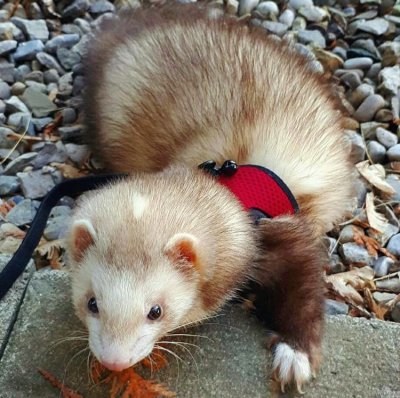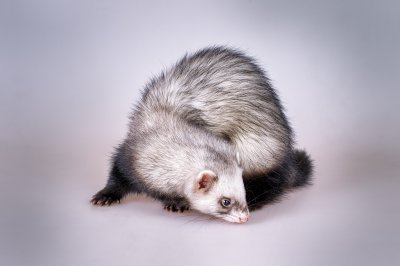There are oodles of cat and dog breeds but when it comes to domesticated ferrets, there is only one. The Mustela putorius furo, which is the domesticated ferret, is the only breed we can bring into our homes and care for as pets.
Despite being a single breed, ferrets do not share similar personalities or behavior. You might have a naughty, thrill-seeking ferret and you could have another that is shy and mellow.
Furthermore, pet ferrets come in different colors, patterns, and markings. They do not have a standard body size or coat length as well. Some ferrets can be slender, while others can be stocky.
8 Most Common Colors of Pet Ferrets
The American Ferret Association considers the following colors as the breed standard for pet ferrets.
Albino

Any animal that lacks melanin is an albino and ferrets are no different. Albino ferrets feature a snowy white coat. They do not have markings, but some albino ferrets may have a few golden streaks of guard hair.
Albino ferrets have a pink nose and a pair of red striking eyes, making them highly recognizable. Without these prominent features, a white ferret isn’t truly an albino.
The pristine white coat of albino ferrets makes them an easy favorite among ferret aficionados. The only downside is that they are more likely to develop hearing difficulties as they age.
Black

When we say a ferret is black, we don’t mean to say its fur is dark brown or dark gray. Rather, the ferret is truly jet-black, and its eyes and nose are very much the same way as its fur. Black ferrets may sometimes have white markings on their heads, but these are often barely noticeable.
Black Sable

Black sable ferrets are as dark as black ferrets, but they share a similar pattern to that of sable ferrets. They have a creamy white torso that is covered with black guard hairs.These ferrets also feature a black hood-like mark on their heads that sometimes extends up to their nose. Their eyes are somewhere between dark brown to black.
Cinnamon

Cinnamon ferrets flaunt a white or cream undercoat, which is covered by reddish-brown guard hairs. Their tail and legs are also reddish-brown but are distinctively darker. Cinnamon ferrets have a pink nose and a mask that complements their main color. Cinnamon is the rarest color in ferrets. Because it is so rare, many argue that Cinnamon ferrets are just a variation of the Champagne ferret.
Champagne

Champagne ferrets are often mistaken as chocolate ferrets, as they resemble each other. The only thing that sets the two apart is the saturation of their coat. Champagne ferrets have a diluted chocolate color. Their eyes are usually light brown but can also be burgundy.
Chocolate

This type of ferret has a cream or wheaten-colored undercoat that highlights chocolate brown guard hairs. Chocolate ferrets usually have dark brown eyes, but others have burgundy. Their nose is never dark but rather pink or beige.
DEW

Dark-eyed ferrets are easily mistaken for albino ferrets. DEW ferrets have white fur, a pink nose, and a likelihood of becoming deaf. The only thing that sets DEW ferrets apart from albinos is their eye color, which is either dark brown or black.
Sable

Sable is the most popular color in ferrets for many reasons. One, these ferrets appear similar to raccoons because of their dark brown mask. Another interesting thing about these ferrets is that they seem to look like they are wearing sleeves and pants. Sable ferrets have a creamy white torso, which is a big contrast to their dark brown arms, hind legs, and tail. Adding to this, their nose is baby pink and their eyes are black.
Identifying Ferret Patterns
Aside from distinct colors, you can group ferrets according to their coat pattern.
Bib
A ferret with a bib can be seen having white fur underneath its neck or chest.
Blaze
The blaze pattern is a long white line, which extends from the back of a ferret’s neck to the gap between its eyes. Blaze ferrets have brown or burgundy eyes, a pinkish nose, and four mitts. Other variations include a white bib, color rings surrounding the eyes, and a spotted belly.
Dalmatian
Dalmatian ferrets are white ferrets with dark eyes and random black spots on their backs.
Mutt
The mutt pattern is a generic term for ferrets that have a mix of colors or patterns.
Panda
As the name implies, the panda pattern makes a ferret look much like a panda – dark colored rings around the eyes, as well as dark hips, shoulders, and mitts that contrast the creamy color of the torso.
Point
Point ferrets are standard champagne, chocolate, cinnamon, or sable ferrets with a distinct difference in color saturation on the legs, feet, and tail. It is for this reason that point ferrets are commonly referred to as Siamese ferrets.
Their underside has a noticeable dark line and their face features a V-shaped mask, both of which are just as vivid as the color of their legs. This pattern appears on any color apart from white.
Roan
A ferret with a roan pattern has a brownish coat with thick, white guard hairs.
Solid
The solid pattern is the easiest pattern to recognize, as it looks a lot like it sounds. This group, however, does not include albino ferrets.
Ferrets Can Take on a Different Hue
Another interesting thing about these creatures is that some ferrets tend to take on a slightly different hue when the seasons change. This makes it even more difficult to classify them based on color or pattern.
Ferrets naturally grow a thicker, denser coat as the cold season approaches. When spring comes, they molt heavily and may sometimes change coat and mask colors.
White guard hairs will grow abundantly as they reach old age. This makes them appear even lighter in color.
Are There Deaf Ferrets?
Albino and dark-eyed ferrets, as well as ferrets with panda and blaze patterns, have a high probability of becoming deaf. You can tell if your pet is deaf if it fails to give a response whenever you call its name or use sounds to catch its attention.
Conclusion
Ferrets make incredible pets, as they are affectionate, playful, and innately curious. These beautiful creatures come in many colors and patterns, which makes them even more special! Although there are ferret types that are susceptible to hearing problems, this doesn’t make them disagreeable pets. In the event that you have a deaf pet, you just need to approach it gently from the front, so you won’t stress him out.
Further reading:
- Kim Schilling and Susan A. Brown. (2007). Ferrets For Dummies. Retrieved from amazon.com
- Gerry Buscis and Barbara Somerville. (2001). The Ferret Handbook. Retrieved from amazon.com
- American Ferret Association